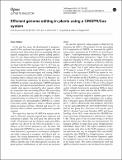| dc.contributor.author | Feng, Zhengyan | |
| dc.contributor.author | Zhang, Botao | |
| dc.contributor.author | Ding, Wona | |
| dc.contributor.author | Liu, Xiaodong | |
| dc.contributor.author | Yang, Dong-Lei | |
| dc.contributor.author | Wei, Pengliang | |
| dc.contributor.author | Cao, Fengqiu | |
| dc.contributor.author | Zhu, Shihua | |
| dc.contributor.author | Zhang, Feng | |
| dc.contributor.author | Mao, Yanfei | |
| dc.contributor.author | Zhu, Jian-Kang | |
| dc.date.accessioned | 2016-05-26T19:16:36Z | |
| dc.date.available | 2016-05-26T19:16:36Z | |
| dc.date.issued | 2013-08 | |
| dc.identifier.issn | 1001-0602 | |
| dc.identifier.issn | 1748-7838 | |
| dc.identifier.uri | http://hdl.handle.net/1721.1/102693 | |
| dc.description.abstract | In the past few years, the development of sequence-specific DNA nucleases has progressed rapidly and such nucleases have shown their power in generating efficient targeted mutagenesis and other genome editing applications. For zinc finger nucleases (ZFNs) and transcription activator-like effector nucleases (TALENs), an engineered array of sequence-specific DNA binding domains are fused with the DNA nuclease Fok1. These nucleases have been successful in genome modifications by generating double strand breaks (DSBs), which are then repaired through non-homologous end joining (NHEJ) or homologous recombination (HR) in different species, including mouse, tobacco and rice. Recently, another breakthrough technology for genome editing, the CRISPR/Cas system, was developed. CRISPR (clustered regulatory interspaced short palindromic repeats) loci are variable short spacers separated by short repeats, which are transcribed into non-coding RNAs. The non-coding RNAs form a functional complex with CRISPR-associated (Cas) proteins and guide the complex to cleave complementary invading DNA. After the initial development of a programmable CRISPR/Cas system, it has been rapidly applied to achieve efficient genome editing in human cell lines, zebrafish and mouse. However, there is still no successful application in plants reported. | en_US |
| dc.description.sponsorship | Chinese Academy of Sciences | en_US |
| dc.language.iso | en_US | |
| dc.publisher | Nature Publishing Group | en_US |
| dc.relation.isversionof | http://dx.doi.org/10.1038/cr.2013.114 | en_US |
| dc.rights | Creative Commons Attribution-Noncommercial-Share Alike | en_US |
| dc.rights.uri | http://creativecommons.org/licenses/by-nc-sa/3.0/ | en_US |
| dc.source | Nature | en_US |
| dc.title | Efficient genome editing in plants using a CRISPR/Cas system | en_US |
| dc.type | Article | en_US |
| dc.identifier.citation | Feng, Zhengyan, Botao Zhang, Wona Ding, Xiaodong Liu, et al. "Efficient genome editing in plants using a CRISPR/Cas system." Cell Research 23 (2013) p. 1229–1232 | en_US |
| dc.contributor.department | Massachusetts Institute of Technology. Department of Brain and Cognitive Sciences | en_US |
| dc.contributor.mitauthor | Zhang, Feng | en_US |
| dc.relation.journal | Cell Research | en_US |
| dc.eprint.version | Final published version | en_US |
| dc.type.uri | http://purl.org/eprint/type/JournalArticle | en_US |
| eprint.status | http://purl.org/eprint/status/PeerReviewed | en_US |
| dspace.orderedauthors | Feng, Zhengyan; Zhang, Botao; Ding, Wona; Liu, Xiaodong; Yang, Dong-Lei; Wei, Pengliang; Cao, Fengqiu; Zhu, Shihua; Zhang, Feng; Mao, Yanfei; Zhu, Jian-Kang | en_US |
| dspace.embargo.terms | N | en_US |
| dc.identifier.orcid | https://orcid.org/0000-0003-2782-2509 | |
| mit.license | PUBLISHER_CC | en_US |
| mit.metadata.status | Complete | |
